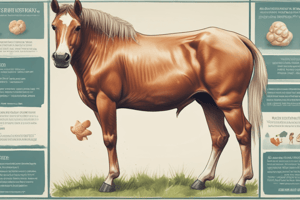Podcast
Questions and Answers
Which of the following statements best describes hydrocarbons?
Which of the following statements best describes hydrocarbons?
- They are organic compounds consisting of hydrogen and carbon atoms. (correct)
- They can only exist in solid form.
- They are inorganic compounds containing metals.
- They are compounds made up of only carbon and nitrogen.
Alkanes are classified as unsaturated hydrocarbons.
Alkanes are classified as unsaturated hydrocarbons.
False (B)
Which type of hydrocarbon contains only single bonds between carbon atoms?
Which type of hydrocarbon contains only single bonds between carbon atoms?
- Alkanes (correct)
- Alkenes
- Aromatics
- Alkynes
Hydrocarbons can be classified into saturated and unsaturated types.
Hydrocarbons can be classified into saturated and unsaturated types.
What type of reaction occurs when hydrocarbons react with oxygen?
What type of reaction occurs when hydrocarbons react with oxygen?
What is the general formula for alkenes?
What is the general formula for alkenes?
The simplest alkane is __________.
The simplest alkane is __________.
Match the types of hydrocarbons with their characteristics:
Match the types of hydrocarbons with their characteristics:
The process of adding hydrogen to an unsaturated hydrocarbon is called _____
The process of adding hydrogen to an unsaturated hydrocarbon is called _____
Which hydrocarbon is known for having a pleasant odor and is often used as a solvent?
Which hydrocarbon is known for having a pleasant odor and is often used as a solvent?
Match the reaction type with its description:
Match the reaction type with its description:
Which type of hydrocarbon consists only of carbon and hydrogen atoms arranged in a linear or branched structure?
Which type of hydrocarbon consists only of carbon and hydrogen atoms arranged in a linear or branched structure?
Which of the following is a common application of hydrocarbons?
Which of the following is a common application of hydrocarbons?
Alkenes can participate in addition reactions due to the presence of double bonds.
Alkenes can participate in addition reactions due to the presence of double bonds.
Cyclic hydrocarbons have a non-linear structure.
Cyclic hydrocarbons have a non-linear structure.
What is a common application of hydrocarbons in everyday life?
What is a common application of hydrocarbons in everyday life?
All hydrocarbons are derived from fossil fuels.
All hydrocarbons are derived from fossil fuels.
Name a type of hydrocarbon that is characterized by a ring structure.
Name a type of hydrocarbon that is characterized by a ring structure.
What is the primary characteristic of unsaturated hydrocarbons?
What is the primary characteristic of unsaturated hydrocarbons?
The reaction where a hydrocarbon reacts with oxygen to produce carbon dioxide and water is called _________.
The reaction where a hydrocarbon reacts with oxygen to produce carbon dioxide and water is called _________.
Match the following types of hydrocarbons with their descriptions:
Match the following types of hydrocarbons with their descriptions:
Which application of hydrocarbons is NOT commonly found in everyday life?
Which application of hydrocarbons is NOT commonly found in everyday life?
Hydrocarbons can be derived from both natural sources and synthetic processes.
Hydrocarbons can be derived from both natural sources and synthetic processes.
Name one property that differentiates saturated hydrocarbons from unsaturated hydrocarbons.
Name one property that differentiates saturated hydrocarbons from unsaturated hydrocarbons.
Flashcards are hidden until you start studying
Study Notes
Vitamins: Structures, RDA, Sources, Deficiencies
- Vitamin A:
- Involved in reproductive functions, growth, and development
- Crucial for vision (maintaining healthy light transduction cells)
- Essential for proper calcium and phosphorus metabolism
- Part of RNA formation
- Deficiency can lead to reproductive issues, vision problems, and poor bone health
- Sources include various fruits and vegetables
- Vitamin D:
- Important for calcium and phosphorus balance in blood
- Plays a role in bone development and health
- Deficiency might cause severe growth retardation in children and osteomalacia (softening of bones) in adults
- Potential for skeletal deformities
- Sources: dietary sources, sunlight
- Vitamin E:
- Antioxidant, protecting tissues from free radicals
- Aids in red blood cell creation
- Prevents oxidation of lipid-based cell membranes
- Sources include almonds, spinach, wheat, asparagus, and other plant-based foods
- Vitamin K:
- Crucial for protein creation, aiding in blood clot formation
- Regulates calcium levels
- Vital for wound healing and stopping bleeding
- Sources include spinach, Brussels sprouts, asparagus, broccoli, and green chilies
- Deficiency can lead to excessive bleeding
- B Vitamins (Table):
- Thiamin (B1): Essential for converting sugar to energy, supports healthy mucous membranes
- Riboflavin (B2): Key for oxidation-reduction reactions, maintaining healthy skin, vision, growth, and red blood cells
- Niacin (B3): Converts carbohydrates, proteins, and fats into energy; supports digestion and nerve function
- Pantothenic Acid (B5): Helps break down macronutrients for energy; crucial for various bodily functions
- Pyridoxine (B6): Aids protein, carbohydrate, and fat metabolism; important during pregnancy and for cell production
- Folate (B9): Required for red blood cell production; prevents anemia, low birth weight and prematurity
- Cobalamin (B12): Supports red blood cell health and a healthy central nervous system; works with B9; crucial for proper metabolism
- Biotin (B7): Essential for fatty acid and glucose metabolism; critical for the body's energy production
- These B vitamins work together with other B vitamins, carbohydrates, proteins and fats to provide energy.
- Vitamin C:
- Regulates the immune system, relieves muscle soreness
- Involved in collagen and norepinephrine production
- Acts as an antioxidant, boosts white blood cell activity
- Promotes healthy skin, teeth, and bones
- Sources include citrus fruits, amla, and leafy vegetables
Additional Information
- RDA values and potential side effects are mentioned in the text.
- The provided images include chemical structures for some vitamins.
- Questions, including multiple-choice and fill-in-the-blank format, are anticipated.
Studying That Suits You
Use AI to generate personalized quizzes and flashcards to suit your learning preferences.




